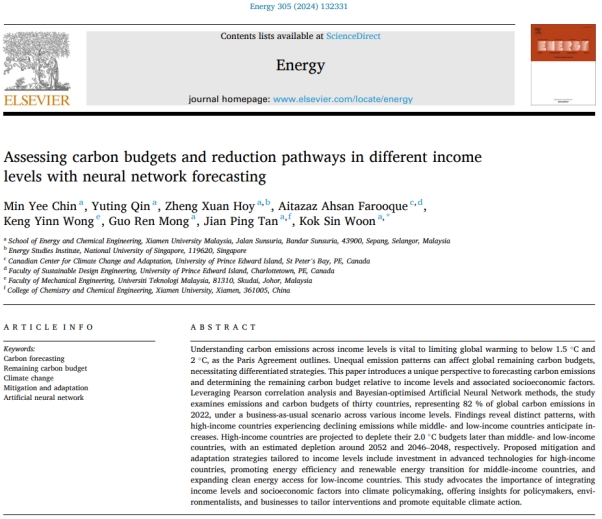The Research and Postgraduate Centre congratulates Chin Min Yee, Qin Yuting, Hoy Zheng Xuan, Asst. Prof. Dr. Mong Guo Ren, Asst. Prof. Dr. Tan Jian Ping, and Assoc. Prof. Ts. Dr. Vincent Woon Kok Sin (corresponding author) from the School of Energy and Chemical Engineering, for their recent research article published in Energy, an SCI Q1 journal with the latest impact factor of 9.0.
Chin Min Yee and Hoy Zheng Xuan are both Master’s graduates in New Energy Science and Engineering (NESE), while Qin Yuting completed her Bachelor’s degree in NESE and is currently pursuing her Master’s degree at the Hong Kong University of Science and Technology.
This research is conducted in collaboration with Prof. Dr. Aitazaz Ahsan Farooque from the University of Prince Edward Island and Asst. Prof. Dr. Wong Keng Yinn from the Universiti Teknologi Malaysia. The project is financially supported by the Ministry of Education Malaysia through the Fundamental Research Grant Scheme (FRGS/1/2020/TK0/XMU/02/2) and Xiamen University Malaysia through the Xiamen University Malaysia Research Fund (XMUMRF/2019-C4/IENG/0022) and (XMUMRF/2023-C11/IENG/0057).
In the paper entitled “Assessing carbon budgets and reduction pathways in different income levels with neural network forecasting”, the researchers forecasted carbon emissions and determined the remaining carbon budget (RCB) relative to income levels and associated socioeconomic factors using Pearson correlation analysis and Bayesian-optimized Artificial Neural Network (ANN) methods. Notably, this research found that high-income countries are experiencing declining emissions, while middle- and low-income countries are expected to see increases. High-income countries are projected to deplete their 2.0 °C budgets later than middle- and low-income countries, with an estimated depletion around 2052 and 2046–2048, respectively. Mitigation and adaptation strategies that are tailored to income levels are proposed to address these disparities.

The published full article can be accessed at https://doi.org/10.1016/j.energy.2024.132331

Graphical abstract of this research

Chin Min Yee: “I am deeply grateful to my supervisor, Dr. Vincent, for his invaluable guidance and unwavering support throughout my postgraduate studies. I would also like to extend my sincere gratitude to all my peers for their strength, knowledge, and collaborative efforts on this project.”

Qin Yuting: “I would like to express my gratitude to my senior, Ms. Chin Min Yee who has helped and given me encouragement. Last but not least, I extend my gratitude to all my family and friends who have accompanied and supported me along this path.”

Hoy Zheng Xuan: “I’m pleased to have had the opportunity to work with this research team, despite having graduated. Contributing my knowledge of neural networks for forecasting carbon emissions has been a fulfilling experience. Big thanks to Dr. Vincent and the team for enabling me to be a part of this impactful work.”

Dr. Tan Jian Ping is an Assistant Professor and Industrial Training Coordinator for Chemical Engineering Program from the School of Energy and Chemical Engineering. He is among the founding members of Bio-Alliance (A-FEED), consortium led by National Institute of Biotechnology Malaysia, initiated by MOSTI to spearhead national bio-based technologies development in agriculture, animal feed and biotechnology.

Ir. Ts. Dr. Mong Guo Ren is an Assistant Professor at XMUM New Energy Science and Engineering Department. His research focuses on converting waste through thermal technologies into bioenergy and bioproducts. He has received several research awards from research competitions and best presenter awards from international conferences.

Ts. Dr. Vincent Woon is an Associate Professor and Head of the PhD Programme at XMUM New Energy Science and Engineering Department. He is dedicated to achieving transformative resilience in climate sustainability by advancing the complex understanding of the environment-economic-social nexus.